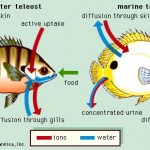freshwater
Image of zebrafish By Pogrebnoj-Alexandroff from Wikimedia Commons
We tend to think of carbon monoxide (CO) only in terms of being a poisonous gas. The reason for its toxicity is due to its ability to bind really tightly to our hemoglobin molecules, which prevents oxygen from being able to bind. In mammals, CO also decrease breathing rate. As you can imagine, it is a pretty terrible gas to breath in when you are a species dependent on hemoglobin for delivery of oxygen to tissues.
Did you know that CO is also produced in our bodies when heme molecules are broken down by…
Freshwater fish are in a constant battle with their environment when it comes to maintaining their electrolyte balance as they are continuously losing ions to the surrounding water. Therefore, they have to actively absorb ions such as sodium, calcium and chloride from the water (see figure below). Prior research has shown that acidic environments cause adult and larva zebrafish to increase sodium uptake from their environment.
Depiction of water and salt homeostasis in freshwater and marine fish.
Researchers Kumai et al (University of Ottowa, Ontario, Canada) have provided evidence to…
Seals and sea-lions gracefully careen through today's oceans with the help of legs that have become wide, flat flippers. But it was not always this way. Seals evolved from carnivorous ancestors that walked on land with sturdy legs; only later did these evolve into the flippers that the family is known for. Now, a beautifully new fossil called Puijila illustrates just what such early steps in seal evolution looked like. With four legs and a long tail, it must have resembled a large otter but it was, in fact, a walking seal.
Natalia Rybczynski unearthed the new animal at Devon Island, Canada…
